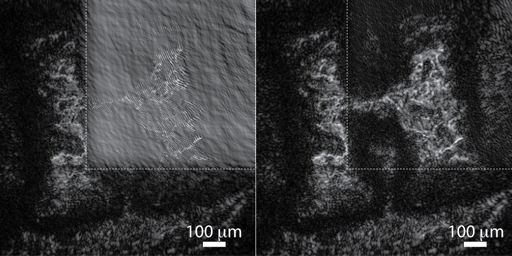| Suppression of Zero Order in Digital Holography |
Investigators: Nicolas Pavillon |
|
Summary: We investigate software methods to suppress the zero-order term in digital holography. |
|
The recording settings in digital holography enable the acquisition of the so-called coherent terms, which make it possible to then retrieve the amplitude and the phase of the recorded wavefront. However, the intensity terms, also denoted as zero-order terms, are also present in the hologram. In order to correctly retrieve the amplitude and phase information from a hologram, the zero-order terms must thus be suppressed. Most existing methods, based on classical linear filtering, impose requirements and limitations on the bandwidth of the signal, either in spatial or temporal resolution. |
|
 |
| Reconstruction in amplitude of a hologram recorded on the reflection on a coin. (Left) Standard reconstruction, where the constant zero-order disrupts the image, and (Right) Nonlinear reconstruction, where the zero-order is intrinsically suppressed. |
We developed a new filtering method based on nonlinear operators, which intrinsically suppresses the zero-order terms (see figure). The approach is based on filtering in the cepstral domain, defined as the logarithm of the modulus of the Fourier transform of the signal, where the various terms recorded in the hologram can be readily separated and filtered. This method presents the advantage of being noniterative, and thus permits live reconstruction. Furthermore, we could demonstrate that this filtering method provides an exact reconstruction in the absence of noise, thus making it suitable for highly resolved measurements.
This method loosens the requirements on signal bandwidth, thus enabling full spatial resolution (diffraction-limited) reconstruction with a single acquisition (one-shot). Furthermore, as the zero-order suppression is intrinsic to the filtering method, it pushes towards automated hologram reconstruction, as most present method require manual intervention during the reconstruction process. |
|
Collaborations: Christian Depeursinge, Michael Unser |
|
Past Investigators: Chandra Sekhar Seelamantula |
|
|
Funding: This work is supported by the Swiss National Science Foundation (205320-120118), the Center for Biomedical Imaging (CIBM) of the Geneva-Lausanne universities and the École polytechnique fédérale de Lausanne (EPFL) and the Hasler, Leenards, and Louis-Jeantet foundations. |
|
|
[2] | N. Pavillon, C.S. Seelamantula, J. Kühn, M. Unser, C. Depeursinge, "Suppression of the Zero-Order Term in Off-Axis Digital Holography Through Nonlinear Filtering," Applied Optics, vol. 48, no. 34, pp. H186-H195, December 2009.
|
|
|
|
